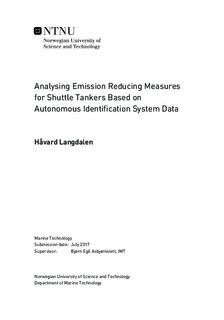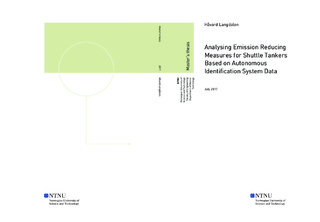| dc.description.abstract | Many of the oil installations on the Norwegian Continental Shelf are dependent on shuttle tankers transporting the produced oil to shore. Shuttle tanker operations contribute to considerable emissions of volatile organic compounds (VOC). VOC is oil vapor that is mainly produced during offloading of oil between the offshore storage facility and the shuttle tanker. VOC is harmful to human and animal life and contributes to greenhouse gas emissions. It is possible to recover the VOC and utilise it as fuel for the shuttle tankers. VOC recovery and utilisation reduces environmental harmful emissions and reduces the overall fuel consumption.
Automatic Identification System (AIS) data is analysed in order to find an operational profile for the shuttle tankers. AIS is a global collision avoidance system mandatory on all larger vessels. The AIS provide information about the vessel such as position, speed and identification. The operational profile is used to assess the effect of implementing VOC recovery and utilisation as fuel for shuttle tankers operating on the Norwegian Continental Shelf.
The AIS data consists of 33 shuttle tankers with over 1.8 million individual AIS messages. In order to reduce the scope and complexity of the analysis, only four shuttle tankers are included in the analysis. First, a heuristic analysis of the four vessels is conducted to find an operational profile. Thereafter, a detailed analysis of one vessel for a 23 day period is conducted in order to assess the quality of the heuristic method.
The results show that the heuristic approach is a sufficient method for analysing large amounts of data. The average operational profile for the analysed shuttle tankers is notable close to expected outcome. However, a detailed analysis points out certain flaws in the heuristic analysis that show significant changes for the 23 day period.
There is a considerable VOC reduction potential. Assuming a recovery rate of 100% of the VOC emissions, the shuttle tankers can save fuel corresponding to 27-70 of hours of transit per offloading operation. | |

